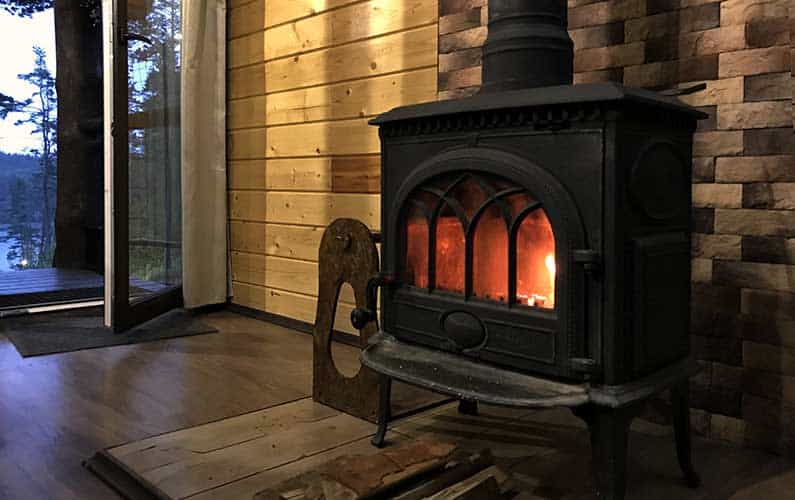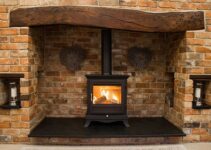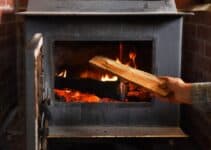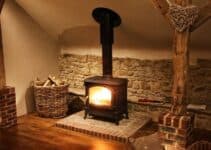Homeowners looking to warm their living space with the traditional crackle and glow of a log burner can often feel discouraged when they glance at some of the costs involved.
With new stoves regularly priced at £500 or more, and premium models running into the thousands, it’s no wonder that keen DIY-ers may want to try to save on any additional labour costs by carrying out the stove installation themselves.
So can you install a log burner yourself? The short answer is yes! There’s no legal reason why you can’t install a wood stove on your own. Skilled, dedicated, and experienced home improvers with time and energy to spare may deem it worth the effort in order to save a few hundred pounds on getting in a certified engineer.
That being said, just because you can legally install a stove yourself doesn’t mean it’s a good idea. In fact, our first and foremost recommendation would always be to have a HETAS engineer fit the stove and any accompanying flue systems, due to the risks and regulations involved.
Without the proper research, preparation, and execution, you leave yourself open to installing a faulty, potentially dangerous appliance, with all the financial and safety implications that entails.
Today, we’ll be taking a closer look at some of the things you’ll want to consider closely before trying to take on this DIY task yourself.
Are You Allowed to Install Your Own Log Burner?
Let’s start with the basics – is it legal? The answer to this is yes. In England and Wales there is no law barring you from installing your own log burner, as long as you follow certain regulations and have the work signed off by Building Control.
What does that mean in practice?
Well, your first step should be PlanningPortal.co.uk, where you can find the necessary regulations relating to the installation of wood stoves.
Familiarise yourself closely with these regulations, as failure to adhere to them could result in you having to refit the stove or getting in a professional to fix the job you started.
Once you’ve researched the practicalities and regulations involved in ensuring a stove is fitted properly, the next step is to inform your Local Council’s Building Control department.
This must be done before any work takes place, as they will need to discuss with you your plans and deem you ‘competent’ to carry out the work yourself.

Be warned, the application itself can cost between £100 and £200, so when you’re factoring in how much money can be saved, this is a cost that has to be considered.
Most Building Control departments will then send an officer out to your home to see where you’re planning on fitting the stove, to speak with you about the regulations, and carry out final assessments as to whether or not you can be signed off as suitable for completing the work yourself.
Different Building Control departments, and different officers, may wish to see different forms of evidence, written or otherwise, to determine your fitness to carry out the work, so it pays to be prepared.
Don’t leave it up to your local council officer to tell you the regulations – read up on them yourself so that you’re in the know!
Then, once you’re given the green light to get started on the work, it’s over to you. Once the stove is fitted, you’ll need it to be signed off and certified.
Some councils may request that a HETAS-registered engineer visit the site and sign off the work you’ve done.
Whether this will result in further costs to you can depend on the Council, so try to find out early on in the process whether there are likely to be any further charges after the initial Building Control application, to avoid unpleasant surprises.
What Happens If I Don’t Get My Wood Burning Stove Signed Off?
Some people are discouraged by the paperwork, the cost, and the delay that are inevitable parts of having your log burner properly regulated.
However, if you decide to go ahead with installing the stove without having it signed off and approved by Building Control, you could land yourself in a great deal of trouble further down the line.
If you wish to sell the property in the future, solicitors can request safety certificates for any appliances or features of the home that require it.
Failing to provide this can raise red flags and, at best, could result in you having to dismantle the stove or labelling it as dysfunctional before selling the home. This could put a dent in the value of the property, as it will require work from a new owner to rectify.
An even worse case scenario is that, by failing to have your log burner installation properly supervised, you end up with a dangerous or faulty stove system that could lead to house fires, carbon monoxide poisoning or serious property damage.
The legal as well as human cost of such accidents can be monumental. In short, it’s just not worth the risk for the sake of a few application forms and a few weeks’ delay.
Is It Safe to Install a Log Burner Myself?
The main risks of installing a log burner yourself are carbon monoxide leaks, improper insulation leading to house fires, and improper positioning of the stove. All of these faults can result in catastrophic damage to property and life.
Another, less severe but still frustrating risk, is that the function of your stove is limited. Without a proper flue system, your stove may struggle to operate at its full potential.
Exhaust fumes and smoke could leak into your living room or other parts of the house which, even if they don’t prove fatal, can be unpleasant and unhealthy.
In short, if you have any doubts about your ability to install a log burner to the relevant safety specifications, invest in a HETAS-certified engineer to carry out the work instead.
Can I Install a Log Burner myself UK?
What are some other factors to consider when deciding whether you can install a log burner yourself?
Remember that fitting a stove is rarely as simple as placing it beneath a working chimney and hooking it up to a ventilation shaft.
Quite often you may find you need to prepare a hearth space, install non-combustible floor pads and wall protection, design and fit a flue system, or carry out chimney repairs to ensure the lining of the chimney is suitable for exhausts.
These tasks can involve heavy lifting, working on roofs, a fluent knowledge of flue systems and how they operate, and a great deal of time, patience, and energy.
It’s worth hiring professional help for parts of the installation that you don’t feel qualified or willing to safely do yourself.
Feel confident buying and designing the flue system but don’t like heights? Why not hire a roofer to get the flue liner down the chimney for you.
Happy to do some tiling round the hearth but not sure how to fit a stove pipe properly? Maybe it’s worth getting a HETAS engineer in for that specific part.
Don’t be afraid to ask, and pay, for professional help wherever you feel it’s needed.
Can You Install a Log Burner Yourself in an Existing House?
There’s usually no legal reason as to why you shouldn’t be able to install a log burner yourself in an existing house that you own, though you should be mindful of the safety implications that we’ve already discussed.
In listed properties, you may need permission if you are planning on installing a new chimney system or external twin-wall flue system that could interfere with the look or character of the property.
Once again, consulting your Local Council and making the relevant applications is crucial.
Fines for carrying out renovation or alterations on a listed building without proper permission can be hefty.



